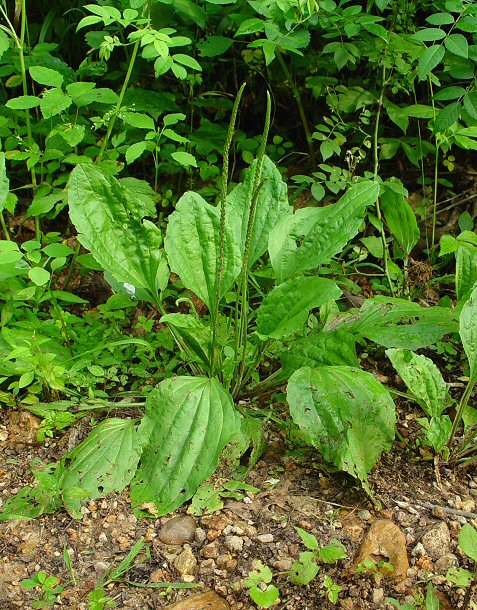Plantago rugelii Decne.
Rugel's Plantain

Native
CC = 0
CW = 0
MOC = 76
© DETenaglia
Plantago rugelii Decne.Rugel's Plantain | |
 |
Native CC = 0 CW = 0 MOC = 76 |
© DETenaglia |
|
Family - Plantaginaceae Habit - Perennial forb, often flowering the first year, with numerous, slender, fibrous roots, the rootstock unbranched and erect at the glabrous tip. Stems - Aerial stems absent. Leaves - Leaves in a dense basal rosette, with short to long, winged and shallowly grooved petioles, usually reddish- or purplish-tinged at the base, arched or spreading to loosely ascending. Leaf blades 4-20 cm long, 1.5-12.0 cm wide, broadly elliptic, rounded or broadly angled to a bluntly pointed tip, mostly short-tapered at the base, less commonly rounded or narrowly cordate, the margins entire or more commonly with 3-7, widely spaced, small, blunt teeth per side, the surfaces glabrous or nearly so, dark green, with mostly 5 or 7 main veins, these all arising from the blade base and appearing arched or curved.
Inflorescence - One to several per plant, terminal, elongate spikes, 5-35 cm long, 4-12 mm in diameter, densely flowered for the entire length (the axis not visible between the flowers) or the lowermost flowers sometimes more widely spaced, the stalk 5-30 cm long, erect or strongly ascending at flowering and fruiting, glabrous or nearly so, the axis solid, circular in cross-section. Bracts 1.0-2.5 mm long, similar in length, shorter than the flowers (usually shorter than the calyces), narrowly lanceolate-triangular, with narrow, translucent or dark purple margins and a prominently keeled, green midnerve, angled or more commonly tapered to a sharply pointed tip, glabrous.
Flowers - Calyces deeply 4-lobed, 1.5-2.5 mm long, actinomorphic, narrowly lanceolate-triangular, angled or more commonly tapered to a sharply pointed tip, the prominently keeled, green midnerve glabrous, the narrow, translucent or dark purple margins thin and papery. Corollas not noticeably zygomorphic, the lobes 0.7-1.2 mm long, lanceolate to narrowly ovate-triangular with a truncate base, sharply pointed at the tip, the margins entire, translucent white, all of the lobes spreading to reflexed at flowering, reflexed at fruiting. Stamens 4, the anthers horned. Pistil 1 per flower, of 2 fused carpels. Ovary superior, 2-locular, with 1 to several ovules per locule, the placentation axile or appearing more or less basal. Style 1.
Fruits - Membranous capsules 4-7 mm long, narrowly ellipsoid or narrowly ovoid, circumscissile well below the midpoint. Seeds 4-10 per fruit, 1.5-2.5 mm long, irregularly ovate to somewhat quadrate, angled, the surface lacking a well-defined flattened or concave area, otherwise very finely pitted or appearing pebbled, dark brown to black, shiny.
Flowering - May - October. Habitat - Streambanks, pond margins, oxbows, marshes, forest openings, fields, ditches, fencerows, lawns, sidewalks, railroads, roadsides, and open, disturbed areas. Origin - Native to the U.S. Lookalikes - Other plantains, especially P. major (which is much less common). Other info. - This weedy species can be found throughout Missouri and is the most common species of broad-leaved Plantago in the state. Beyond Missouri its range extends across most of the eastern half of the continental U.S. and into Canada. The plant is easy to identify from its large, glabrous leaves with broad blades, parallel venation and red coloration at the base of the petioles, and its long, cylindrical inflorescences. The red basal coloration distinguishes this species from the closely related P. major. The leaves of this species (and many species in this genus) can be eaten, either raw or cooked. The seeds are often a component of bird seed. Photographs taken in the Ozark Scenic Riverways, Shannon County, MO., 6-15-03 (DETenaglia); also at Creve Coeur Lake Park, St. Louis County, MO, 7-16-2022 (SRTurner). |